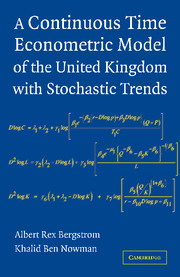Book contents
- Frontmatter
- Contents
- List of Figures and Tables
- Foreword by Peter C. B. Phillips
- Preface
- 1 Introduction to Continuous Time Modelling
- 2 Continuous Time Econometrics with Stochastic Trends
- 3 Model Specification
- 4 Steady State and Stability Analysis
- 5 Empirical Estimation of the Model and Derived Results
- References
- Author Index
- Subject Index
5 - Empirical Estimation of the Model and Derived Results
Published online by Cambridge University Press: 03 March 2010
- Frontmatter
- Contents
- List of Figures and Tables
- Foreword by Peter C. B. Phillips
- Preface
- 1 Introduction to Continuous Time Modelling
- 2 Continuous Time Econometrics with Stochastic Trends
- 3 Model Specification
- 4 Steady State and Stability Analysis
- 5 Empirical Estimation of the Model and Derived Results
- References
- Author Index
- Subject Index
Summary
Introduction
In this chapter we now turn our attention to the empirical analysis of the new continuous time macroeconometric model, using UK data and the exact Gaussian method of Bergstrom [1997]. Since the model of Bergstrom [1997] is linear in the variables, although nonlinear in the parameters, while the continuous time macroeconometric model is non-linear in both the variables and the parameters, it was necessary, in the estimation, to use a linear (in the variables) approximation to the latter model. This approximation is discussed in Section 5.2, where we also present and discuss the parameter estimates. In the subsequent sections we derive and discuss the properties of the estimated model, using the results obtained in earlier chapters. The time lag distributions with which the variables each depend on the past values of other variables on which they are directly dependent have been derived from the estimated parameters using the formulae derived in Appendix B of Chapter 3. They are presented (graphically and through a table of their means and modes) and discussed in Section 5.3. The steady state and stability properties of the estimated model have been derived using the results obtained in Chapter 4 and are discussed in Section 5.4. Finally, in Section 5.5, we discuss the post-sample forecasting performance of the estimated model and compare it with that of an unrestricted second-order VARX model (vector autoregressive model with exogenous variables) and Section 5.6 concludes.
Information
- Type
- Chapter
- Information
- Publisher: Cambridge University PressPrint publication year: 2007
